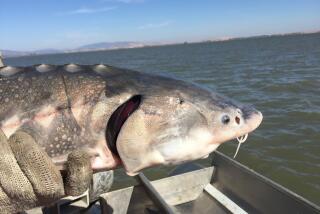Catch of the Day: Sharp Tale of Scramble for Fish Eggs
CAVIAR
The Strange History and
Uncertain Future of the
World’s Most Coveted Delicacy
By Inga Saffron
Broadway Books
272 pages, $23.95
*
Serving as Moscow correspondent for the Philadelphia Inquirer in the mid-1990s, Inga Saffron developed an intense relationship with one of Russia’s most prized delicacies:
“I rolled the eggs over my tongue, allowing the taut spheres to detonate a few at a time.... New and different tastes came in explosive bursts, as the initial fishiness gave way to more complex flavors and aromas. I was reminded of other rich foods--olives, pine nuts, smoked salmon. But it was the physical sensation, the way the firm casings of the eggs gave way as they popped against my tongue and cheek, that dominated the experience. What I realized was that caviar was something you experienced in your mouth, not your stomach.”
Caviar are the lightly salted eggs of the sturgeon, an ancient fish that has been swimming around since before the dinosaurs but whose future now looks bleak. In her sharp-eyed, informative and briskly written book “Caviar,” Saffron examines the natural, economic and gastronomical history of the sturgeon and its eggs.
A “big, slow-moving beast, sweetly curious about the goings-on above its head and lumpenly passive when it runs into danger,” the sturgeon was once found all over the world, in the major rivers of China, Central Asia, Europe and North America.
In the 19th century, Hamburg merchants made a fortune selling caviar from sturgeon caught in the Elbe River. The trouble was, business was so profitable that within a few decades the sturgeon had been fished out. The same thing happened in 1880s America, in New Jersey, of all places.
Springing up alongside the sturgeon-rich Delaware River, a little boomtown appropriately known as Caviar, Saffron tells us, “supplied more of the world’s caviar during the 1880s than any place on earth.” But before long, the sturgeon of the Delaware River met a fate similar to their German cousins in the Elbe. Although industrialization and pollution were an additional threat to sturgeon, it would seem from Saffron’s account that in most cases it was overfishing that decimated the sturgeon even before pollution had a chance to do its damage.
In one of history’s nicer ironies, by the 1920s only the Soviet Union, a state newly consecrated to the welfare of the masses, was still producing caviar, the comestible most strongly associated with luxury and elitism. And what saved the Russian sturgeon from falling victim to the same sad fate as its American and European counterparts was strict, centralized government control of the caviar industry. Earlier, in America, many of the people involved in the caviar business were sufficiently concerned about the perils of overfishing to beg for government regulation. But then (as now) there was a stubborn ideological resistance to regulate an industry even for its own good.
The Soviets achieved an admirably efficient, reliable and very profitable system with regard to the production and distribution of caviar. Saffron aptly compares it with the system used by De Beers in controlling the production, supply and price of the world’s diamonds.
The collapse of the Soviet Union spelled chaos and, quite probably, doom for the sturgeon, as jobless former Soviets scrambled to make some much-needed cash in the newly unregulated caviar business.
Initially, in the early 1990s, there was a great boom. Caviar was everywhere. But all too soon, not surprisingly, sturgeon were not.
Although, as Saffron describes, there are unscrupulous people who’ve turned the sale and distribution of caviar into a fishy version of the illicit drug trade, the problem goes beyond that. One of the people Saffron portrays is an honest and likable Russian caviar producer who understands the problem and supports efforts to restock the waters and restrict the catch. Still, he wants to make a living and thus is inclined to take an overly optimistic view of the problem. Saffron also explains very lucidly the difficulties that have plagued international regulatory efforts. While many of the former Soviet republics have failed to address the problem, she notes, Iran has been doing an admirable job of regulating and restocking its part of the Caspian Sea.
If the wild sturgeon is endangered, what about fish farms? Saffron takes us on a fascinating visit to Northern California, where a small group of assiduous individuals are doing their best to breed the once-populous white sturgeon in captivity. She also visits an even more ambitious project in Volgograd, involving a much wider range of breeding stock.
Not only does Saffron ably convey the enthusiasm and dedication of the men engaged in these projects, she also gives us a good sense of the economic precariousness of such enterprises. It can take at least 10 years before a baby sturgeon is old enough to bear its precious eggs. In a time of melting icebergs, disappearing rain forests and the spread of HIV, it may seem frivolous (though at least considerate) of us to worry whether future generations will know the pleasure of tasting caviar. But the paradigm that emerges from the sturgeon’s story is one that can be seen again and again: You can’t have your caviar and eat it too--not unless firm measures are taken to ensure a balance between consumption and supply.
More to Read
Eat your way across L.A.
Get our weekly Tasting Notes newsletter for reviews, news and more.
You may occasionally receive promotional content from the Los Angeles Times.







